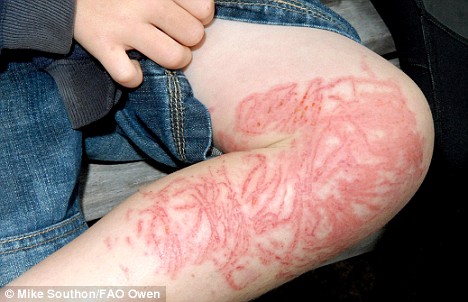Every year around February and March, El Médano is visited by jellyfish. A jellyfish sting is a pretty excruciating experience and so knowing how treat the resulting burn is a handy thing to know. Now it is true that not all jellyfish are painful to touch and not many are actually deadly.
How to Treat a Jellyfish Sting
Things you should do:
- First off, stop any strenuous exercise. If you continue to pump the toxins through the body you will notice a pain spreading through the chest. Sit down and relax and treat the burn.
- Take a hot water shower. As hot as you can bear. The hot water destroys the protein cells that contain the toxin.
- Get rid of all the tentacles (make sure you don’t touch them with your bare skin. Use gloves or tweezers)
- Keep the area wetted with the type of water you were stung in (salt water or fresh water)
- Scrape the burnt skin CAREFULLY with a sharp edge such as with a knife, safety razor or credit card (make sure to only scrape in one direction)
- Apply heat (a first aid course in Australia taught me to treat land animal stings with cold and water animal stings with heat, i.e.. very hot water)
The thing that helped me the most when I got stung was take a hot shower. Hot as in, as warm as I could bear it and then increasing the temperature when I got used to that setting. From what I have read the toxins are protein cells much like egg-white cells which get neutralized by heat.
Things you should NOT do:
- Apply fresh water on the area
- Apply alcohol
- Urinate on the area
- Apply ammonia
- Apply ice to the wound
- Rub the area (this will only make the protein cells that contain the venom burst and hurt more)
There are a few methods on how to remove the venom of a jellyfish from the skin. One is to make a paste of baking soda and water and apply it to the area and covering it with a cloth.
Prevention
So much for the cures to these very painful stings, now to the prevention.
The best way to avoid a jellyfish sting is of course not to go in the water. If you hear of jellyfish being in the water, just do a land activity, as simple as that.
If you decide you must go in the water, go prepared. A long-leg, long-arm wetsuit will at least protect most of your body, minimizing the area available. Naturally this does not protect your head. I personally have a long wetsuit that is thin for warm waters to stay protected.
There is also a sun cream with jellyfish repellent available on amazon which you can give a try although I have no idea just how effective it is.
When encountering a jellyfish in the water, you will probably only see the bag on the surface and not so much the tentacles. This is true for the portuguese man of war. Remember that the bag is always downstream of the tentacles and the current and wind on the water surface blow the bag and the tentacles follow. So if you are sailing along and see the bag, pass it on the downwind side to avoid any tentacles getting stuck and tangled on your feet.
If you have any more tips of dealing with jellyfish stings, please let me know so that the information is complete.







There are many misconceptions about the treatment of jellyfish stings. Urinating is not a cure but nevermore believe in it.
Any method of heating works quite well : a simple hair dryer blows the right temperature 45°C i.e. around 125°F, miraculous, your blisters disappear, not too hot to burn your skin, but breaking down the venom in a few seconds and suppressing any pain, any blisters, and preventing scars in the following days. A simple hot sheet of paper works, but hot water need an accurate temperature thermometer to be sure to be below 50°C to be sure to not burn heavily your skin and to be around 45°C to break down the venom.
I and my wife, we used successifully this method for many around 100 jelly fish stings over the last 15 years !
Any others methods are inefficient with pain over several days and scars many years laters sometimes.
I got stung in Tunisia, when I was younger, my Dad took me to the one of the hotel staff, they cut a fresh tomato in half, they took me to the beach, where they rubbed sand all over the jelly fish sting, this removes any hair left from the their tentacles, then they washed the sand off, with the fresh water, with the fresh tomato, which was cut in half, rub that all over, the sting, with pips and all, leave to completely dry for about 30min-40minutes, then wash it off with clean water. That actually worked.
I think am really unlucky with jellyfish, mostly everytime I go to the see I come back home in pain and it itches a lot,but to you now av learned how I can treat it